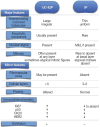Distinctive morphological and molecular features of urothelial carcinoma with an inverted growth pattern
- PMID: 34111910
- PMCID: PMC8353137
- DOI: 10.4132/jptm.2021.04.20
Distinctive morphological and molecular features of urothelial carcinoma with an inverted growth pattern
Abstract
Urothelial carcinoma with an inverted growth pattern (UC-IGP) is a peculiar entity within the spectrum of urothelial lesions. While efforts have been made over the last few decades to unravel its carcinogenesis and relationship with conventional urothelial carcinoma, the exact classification of inverted urothelial lesions is a matter of debate. The morphological features of UC-IGP pose several issues in differential diagnosis with other mostly benign lesions. Various techniques, including immunohistochemistry, UroVysion, and many molecular methods, have been employed to study the exact nature of this lesion. The aim of this review is to provide a comprehensive overview of the morphological and immunophenotypical aspects of UC-IGP. Moreover, we present and discuss the immunohistochemical and molecular markers involved in diagnosis and prognosis of UC-IGP lesions.
Keywords: Immunohistochemistry; Inverted growth pattern; Molecular markers; Urothelial carcinoma.
Conflict of interest statement
The authors declare that they have no potential conflicts of interest.
Figures
References
-
- Jones TD, Zhang S, Lopez-Beltran A, et al. Urothelial carcinoma with an inverted growth pattern can be distinguished from inverted papilloma by fluorescence in situ hybridization, immunohistochemistry, and morphologic analysis. Am J Surg Pathol. 2007;31:1861–7. - PubMed
-
- Bang H, Park H, Park S, et al. Clinicopathologic study of 60 cases of urothelial neoplasms with inverted growth patterns: reclassification by international consultation on urologic disease (ICUD) recommendations. Ann Diagn Pathol. 2020;44:151433. - PubMed
Publication types
LinkOut - more resources
Full Text Sources


